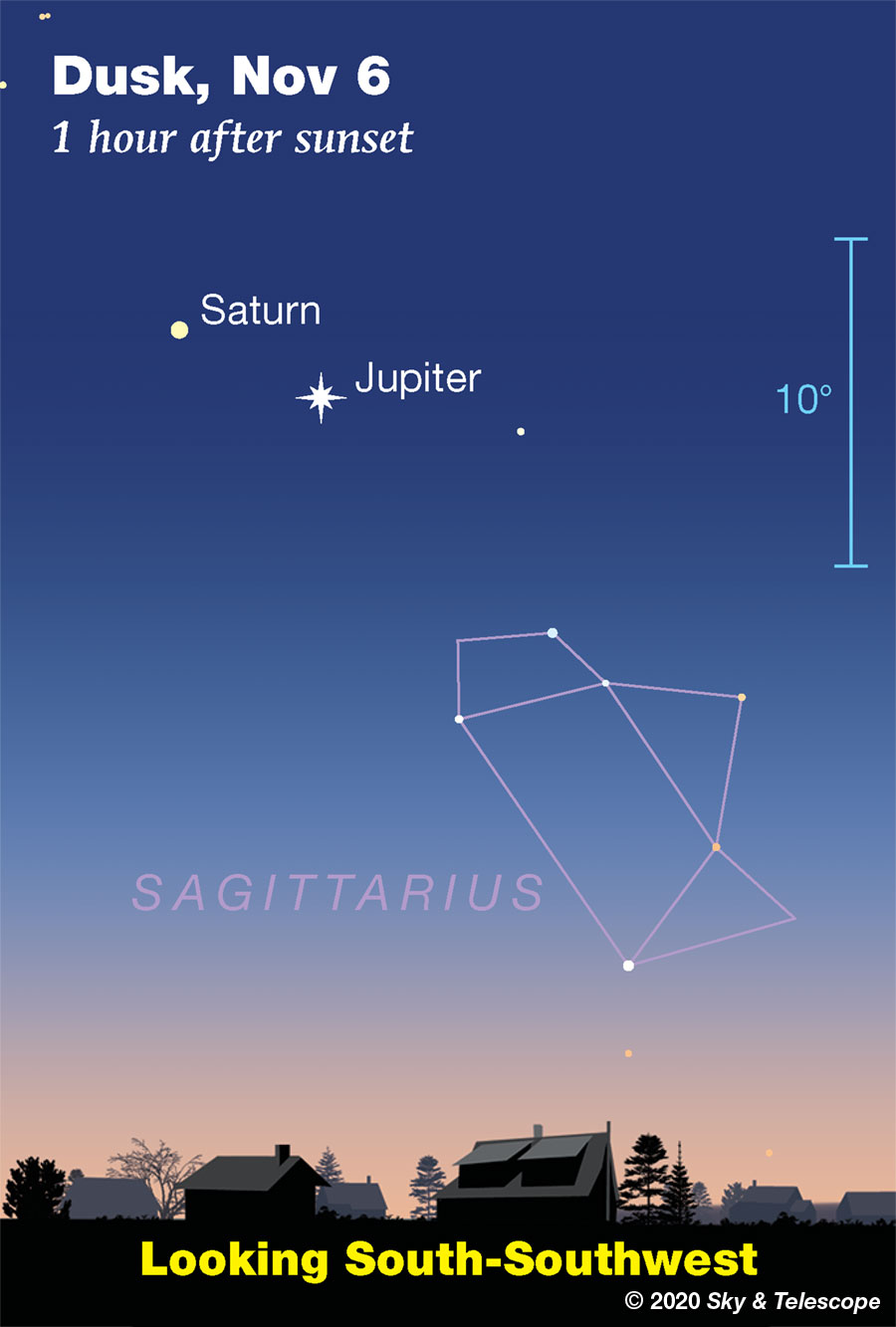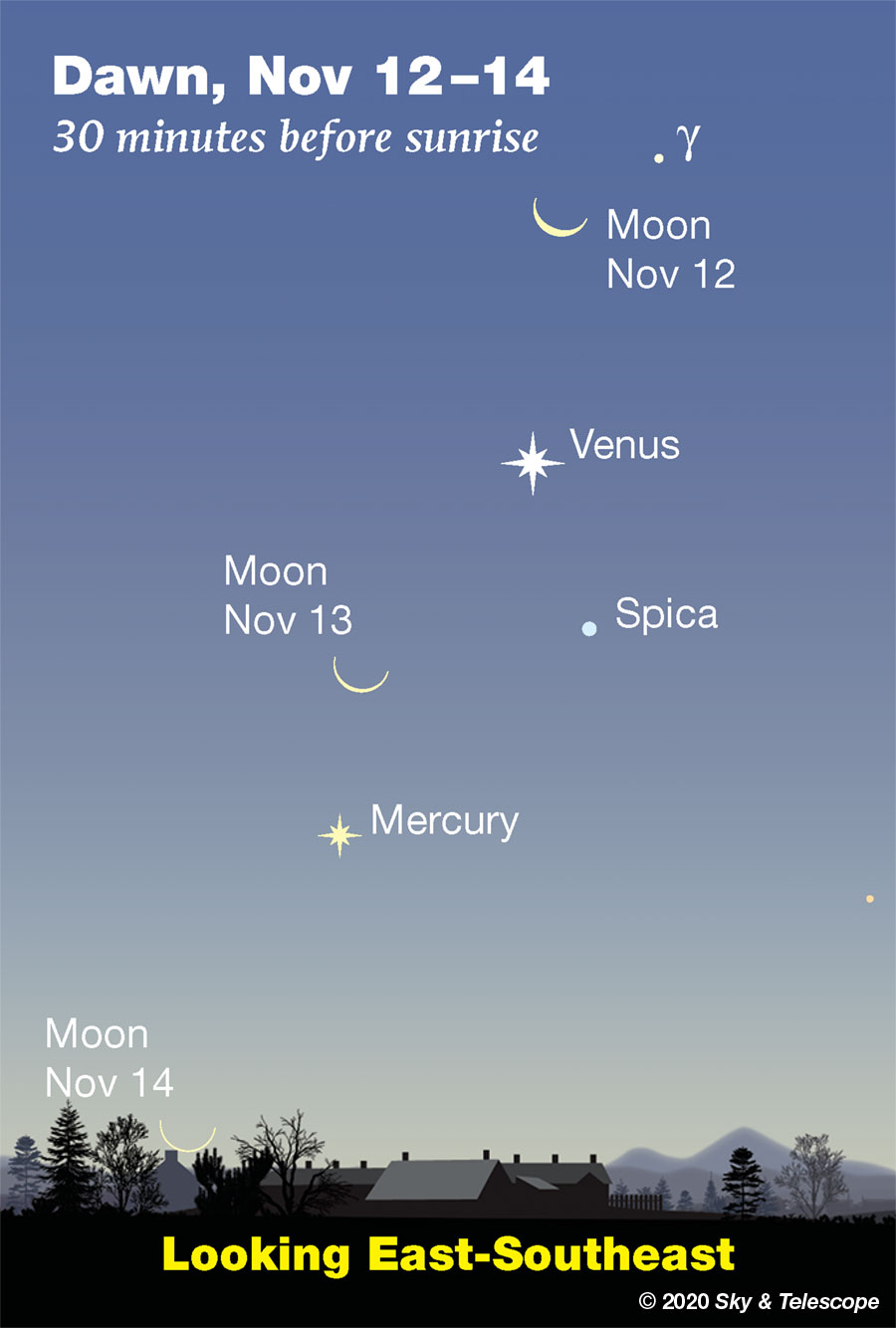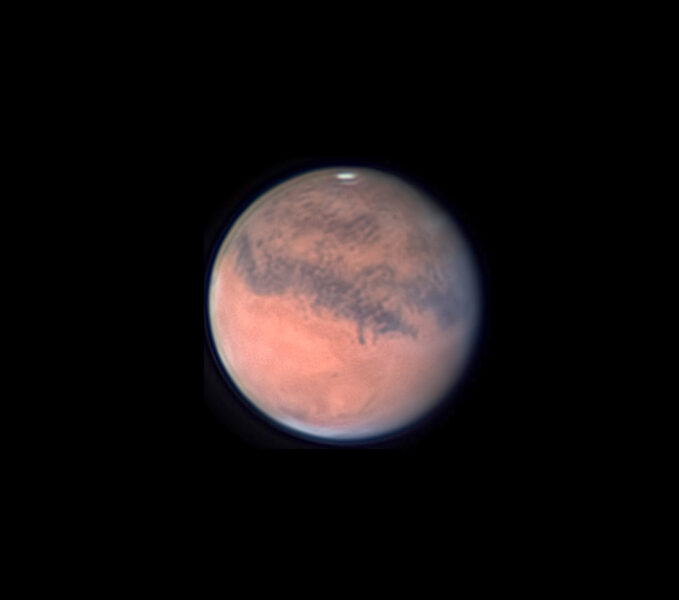FRIDAY, NOVEMBER 6
■ Have you been watching Jupiter and Saturn draw toward each other in the evening sky? Spot them in the south-southwest during and after dusk, as shown below. Through the warm nights of late summer they remained 8° apart. Now they're down to 4.6° apart and closing. Follow them for the rest of the fall until they pass 0.1° apart on December 21st.

■ After dark this week, Capella shines well up in the northeast. Look for the Pleiades three fists at arm's length to Capella's right. As evening grows later, you'll find orange Aldebaran climbing up below the Pleiades.
Then by about 10 p.m. (depending on your location), Orion clears the eastern horizon below Aldebaran.
SATURDAY, NOVEMBER 7
■ Vega is the brightest star in the west in early evening. Its little constellation Lyra extends to its left. Somewhat farther left, about a fist and a half at arm's length from Vega, is 3rd-magnitude Albireo, the beak of Cygnus. This is a fine, colorful double stars for small telescopes.
Farther on in roughly the same direction you come to 3rd-magnitude Tarazed and, just past it, 1st-magnitude Altair.
■ With the Moon gone from the evening sky, now's a great time to explore the telescopic riches of the Milky Way in and around the mouth of Cepheus very high in the north. Use the Deep-Sky Wonders article, charts, and photos in the November Sky & Telescope, page 54.
SUNDAY, NOVEMBER 8
■ Around 8 or 9 p.m. standard time, depending on where you live, zero-magnitude Capella rises exactly as high in the northeast as zero-magnitude Vega has sunk in the northwest. How accurately can you time this? The tipping point in the Vega-Capella balance symb0lizes, to me, the seasonal change from mild evenings to cold ones.
■ Last-quarter Moon, exactly so 8:46 a.m. EST. By the time the Moon rises around 11 p.m., it's more than half a day past exact last-quarter phase. So you'll see its terminator just a trace concave, not straight. The Moon will be in dim Cancer, lower left of Gemini.
MONDAY, NOVEMBER 9
■ By about 8 or 9 p.m. Orion is clearing the eastern horizon. High above Orion shines orange Aldebaran. Above Aldebaran is the little Pleiades cluster, the size of your fingertip at arm's length. Far left of Aldebaran and the Pleiades shines bright Capella.
Down below Orion, Sirius rises around 10 or 11 p.m. No matter where they are, Sirius always follows Orion two hours behind.
■ Happy 86th birthday, Carl Sagan (November 9, 1934 – December 20, 1996). If only.
TUESDAY, NOVEMBER 10
■ Around 9 p.m. this week, the Great Square of Pegasus stands in its level, boxy position very high toward the south. (It's straight overhead if you're as far south as Miami.) Its right (western) edge points very far down toward Fomalhaut. Its eastern edge points less directly toward Beta Ceti, less far down.
Now descending farther: If you have a very good view down to the south horizon — and if you're not much farther north than latitude 40°, roughly Denver, New York, or Madrid — picture an equilateral triangle with Fomalhaut and Beta Ceti as its top two corners. Near where the third corner would be (a bit to the right of that point) is Alpha Phoenicis, or Ankaa, in the constellation Phoenix. It's magnitude 2.4, not very bright but the brightest thing in its area. It has a yellow-orange tint; binoculars help check. Have you ever seen anything of the constellation Phoenix before?
WEDNESDAY, NOVEMBER 11
■ In early evening, Altair shines in the southwest about halfway up the sky: halfway from the horizon to the zenith. Spot it about three or four fists left of brighter Vega. Altair is the only bright star in that area. It's the eye of Aquila, the Eagle.
Just upper right of Altair is 3rd-magnitude Tarazed. Down from there runs Aquila's dim backbone, along the Milky Way if you have a dark enough sky.
This arrangement reminds me of another Summer Triangle bird, Cygnus the Swan, whose long neck and backbone also runs along the Milky Way. Cygnus currently flies high to Aquila's upper right.
THURSDAY, NOVEMBER 12
■ Algol should be at minimum light, magnitude 3.4 instead of its usual 2.1, for a couple hours centered on 6:11 p.m. EST.
■ In the early dawn of lucky Friday the 13th, look south-southeast for the Moon partway between Venus and Mercury, as shown below. Look before the sky gets too bright and you'll spot fainter, 1st-magnitude Spica to their right, making it an uneven quadrilateral.

FRIDAY, NOVEMBER 13
■ Once again, spot Altair high in the southwest soon after dark. Brighter Vega shines three or four fists to its right. Two distinctive little constellations lurk above Altair: Delphinus the Dolphin, hardly more than a fist at arm's length to its upper left, and smaller, fainter Sagitta the Arrow, slightly less far to Altair's upper right. Sky too bright? Use binoculars!
SATURDAY, NOVEMBER 14
■ Draw a line from Altair to Vega, continue the line onward by half as far, and you hit the Lozenge: the pointy-nosed head of Draco, the Dragon. Its brightest star is orange Eltanin, the tip of the Dragon's nose, always pointing toward Vega.
This Week's Planet Roundup
Mercury is having a nice dawn apparition low in the east-southeast. Look for it below or lower left of Venus about 60 to 40 minutes before sunrise, by a little more than a fist at arm's length. Mercury is nicely showy this week, as Mercury goes, at about magnitude –0.5.
Venus (magnitude –3.9, in Virgo) shines brightly in the east before and during dawn, not very high. It rises in darkness about an hour before dawn's first light. Can you keep Venus in view all the way to sunrise and maybe after? Binoculars help as the sky grows bright with day.
Spica, only 1% as bright, glimmers below Venus or to its lower left. The Moon joins the scene on the morning of Friday the 13th, as shown above.
Mars (about magnitude –1.8, in Pisces) is a month past opposition and shrinking into the distance. But it's still 18 arcseconds wide in a telescope, as big as at some oppositions and plenty large to show good surface detail during steady seeing.
Mars shines bright yellow-orange in the east-southeast at dusk, below the Great Square of Pegasus. It's at its highest and best in the south by 9 or 10 p.m.

The classical names refers to the albedo (bright/dark) markings. In terms of physical geography, the bottom of Gomer Sinus is Galen Crater, home of the Curiosity rover for the last five years.
See Bob King's "A Great Year for Mars" in the October Sky & Telescope, page 48, and his Behold Mars! online. To get a map of the side of Mars facing Earth at the date and time you'll observe, you can use our Mars Profiler. The map there is square; remember to mentally wrap it onto the side of a globe. (Features near the map's edges become very foreshortened.)
Jupiter and Saturn (magnitudes –2.2 and +0.6, respectively) tilt down in the west-southwest during and after twilight. Get your telescope on them early, even in twilight, before they sink lower toward the southwest. But don't expect much; both are somewhat farther and smaller than they were during summer, and the seeing that low will likely be poor.
Jupiter is the bright one; Saturn is now only about 4½° to its upper left. Watch them creep toward each other for the rest of the fall. They'll pass just 0.1° apart at conjunction on December 21st, low in twilight, as fall turns to winter.
Uranus (magnitude 5.7, in Aries) is high in the east by 7 or 8 p.m., about 20° east (lower left) of Mars. Uranus is only 3.7 arcseconds wide, but that's enough to appear as a tiny fuzzy ball, not a point, at high power in even a good small telescope.
Neptune (magnitude 7.8, in Aquarius) is equally high in the south at that time. Neptune is 2.3 arcseconds wide, harder to resolve except in good seeing. Check in on them when you're done with Mars: Finder charts for Uranus and Neptune.
All descriptions that relate to your horizon — including the words up, down, right, and left — are written for the world's mid-northern latitudes. Descriptions that also depend on longitude (mainly Moon positions) are for North America.
Eastern Standard Time, EST, is Universal Time minus 5 hours. (Universal Time is also known as UT, UTC, GMT, or Z time.)
Want to become a better astronomer? Learn your way around the constellations. They're the key to locating everything fainter and deeper to hunt with binoculars or a telescope.
This is an outdoor nature hobby. For an easy-to-use constellation guide covering the whole evening sky, use the big monthly map in the center of each issue of Sky & Telescope, the essential magazine of astronomy.
Once you get a telescope, to put it to good use you'll need a detailed, large-scale sky atlas (set of charts). The basic standard is the Pocket Sky Atlas (in either the original or Jumbo Edition), which shows stars to magnitude 7.6.

Next up is the larger and deeper Sky Atlas 2000.0, plotting stars to magnitude 8.5; nearly three times as many. The next up, once you know your way around, are the even larger Interstellarum atlas (stars to magnitude 9.5) or Uranometria 2000.0 (stars to magnitude 9.75). And be sure to read how to use sky charts with a telescope.
You'll also want a good deep-sky guidebook, such as Sky Atlas 2000.0 Companion by Strong and Sinnott, or the bigger (and illustrated) Night Sky Observer's Guide by Kepple and Sanner.
Can a computerized telescope replace charts? Not for beginners, I don't think, and not on mounts and tripods that are less than top-quality mechanically, meaning heavy and expensive. And as Terence Dickinson and Alan Dyer say in their Backyard Astronomer's Guide, "A full appreciation of the universe cannot come without developing the skills to find things in the sky and understanding how the sky works. This knowledge comes only by spending time under the stars with star maps in hand."
![]() Audio sky tour. Out under the evening sky with your
Audio sky tour. Out under the evening sky with your
earbuds in place, listen to Kelly Beatty's monthly
podcast tour of the heavens above. It's free.
"The dangers of not thinking clearly are much greater now than ever before. It's not that there's something new in our way of thinking, it's that credulous and confused thinking can be much more lethal in ways it was never before."
— Carl Sagan, 1996
"Facts are stubborn things."
— John Adams, 1770
 4
4
Comments
Zubenelgenubi 61
November 7, 2020 at 11:00 am
Please check- I believe that the Algol minimum on the night of the 12th is at 5:11 UT, a good one to see almost the whole cycle.
You must be logged in to post a comment.
Rod
November 8, 2020 at 12:59 pm
mary beth, New Jersey Eclipse Fan. I had some guests over yesterday evening. They enjoyed viewing Mars, Jupiter, and Saturn using my 90-mm refractor telescope. At Jupiter the Galilean moons easily observed, cloud bands, and some faint stars in the FOV. Saturn was lovely with shadow of the planet, a bit visible on the rings with Titan near 2:30 position (mirror reverse view, north up). Mars still shows some darker surface features too but a red filter view is even better. The telescope was operating near 130x. It was an enjoyable evening and time well spent observing some planets near the ecliptic last night.
You must be logged in to post a comment.
Rod
November 9, 2020 at 7:43 am
I did enjoy some views of Neptune last night using my 90-mm refractor telescope at 40x and 10x50 binocular views. I used Stellarium and Starry Night to develop star charts for viewing and used the Telrad for easy targeting of the star and planet. [Observed 1800-1836 EST. Last Quarter Moon 1346 UT, 08-Nov-2020. I viewed Neptune tonight using 10x50 binoculars and the telescope at 40x. Neptune distinct blue dot and Phi Aquarii star, slightly orange-yellow color in the field of view. An interesting color contrast while viewing. Neptune retrograde in Aquarius. Starry Night shows Neptune and Phi Aquarii ~ 51' angular separation. I last viewed Neptune near Phi Aquarii star 07-Sep-2019, ~ 1' angular separation. From my stargazing log entry, "Observed 2200-0030 EDT. I observed the close alignment of Neptune retrograding in Aquarius about 1' angular separation from the star, Phi Aquarii." 23-Jun-2020, Neptune began retrograde motion again in Aquarius according to Starry Night.]
You must be logged in to post a comment.
mary beth
November 9, 2020 at 12:05 pm
The early nightfall is very enjoyable. Capella has been so captivating! Fomalhaut is past the meridian right at 8pm CST, still the lonely star.
Rod, you and your guests have certainly been having some memorable evenings! Hope the pasture stays dry so you can continue enjoying the precession. Very interesting about Neptune and the color contrast.
You must be logged in to post a comment.
You must be logged in to post a comment.